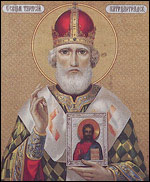|
Saint Tarasius was born in Constantinople, in the family of the affluent and notable courtiers George and Eucratia, who brought up their son in the fear of God and provided him with a good education. While still young he was elevated to the prominent civil position of senator. In 783, when Patriarch Paul of Constantinople died and the question of his successor arose, in the entire city of Constantinople there was not a worthier candidate to be found than the senator Tarasius, who was directly elected to the position of patriarch. However, due to his fervor for Orthodoxy, Saint Tarasius agreed to the election only on condition that an ecumenical council would convened, in order to suppress the raging tempest of the heresy of iconoclasm, which was creating a rift in the Orthodox Church at that time.
|

Saint Tarasius, Patriarch of Constantinople. |
|
|
The heresy of iconoclasm originated in the early 8th century, when the Greek emperor Leo III decreed that all holy icons be taken out of churches and homes, and burned in the city squares. The decree was motivated by a false belief that the worship of icons was a form of idolatry. When the people began to resist this decree, to the persecution of icons Emperor Leo added the persecution of their worshippers, and many of the faithful were tortured and killed at that time. Nevertheless, the people continued to revolt against the Emperor’s decree, and prominent theologians of those times wrote from all sides, denouncing Emperor Leo: as, for example, St. John Damascene from Syria and pope Gregory II from Rome.
After the death of Emperor Leo, his son and successor, Constantine Copronimus, continued the iconoclastic efforts of his father, but decided to try a different approach. He convened a false council, at which the clergy which he had set up condemned the worship of icons. As a result of this false council, not only were icons continued to be destroyed, but also priceless frescoes on the walls of famous cathedrals were plastered over. From persecution of icons Constantine turned to a persecution of holy relics, and then to a persecution of monasteries, which were all either destroyed or turned into barracks, while all the monks were brutally martyred.
The heresy of iconoclasm continued almost throughout the entire 8th century, and only towards the end of it, during the reign of the pious Empress Irene and as a result of the election of Saint Tarasius, the worship of icons was restored. Through the efforts of the Empress and with the full support of Saint Tarasius, the 7th ecumenical council, attended by more than 300 bishops, was convened in 787. The council totally condemned the heresy of iconoclasm, condemned the false council that had been convened by Copronimus, and triumphantly restored the worship of icons by determining that in honoring the icons we honor and worship those who are depicted on them.
The holy Patriarch Tarasius ruled the Church for 22 years and peacefully departed this world in 806.
|